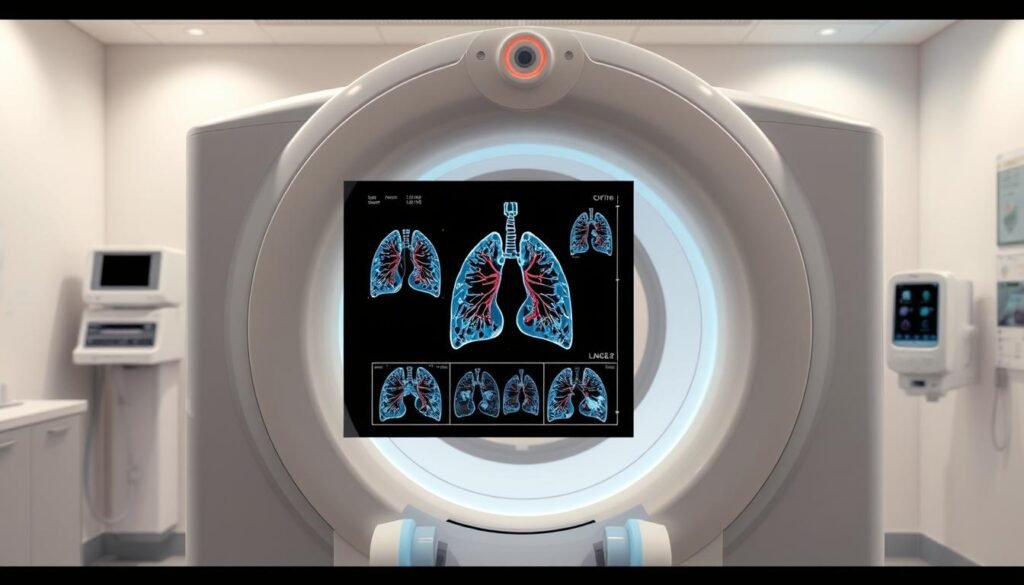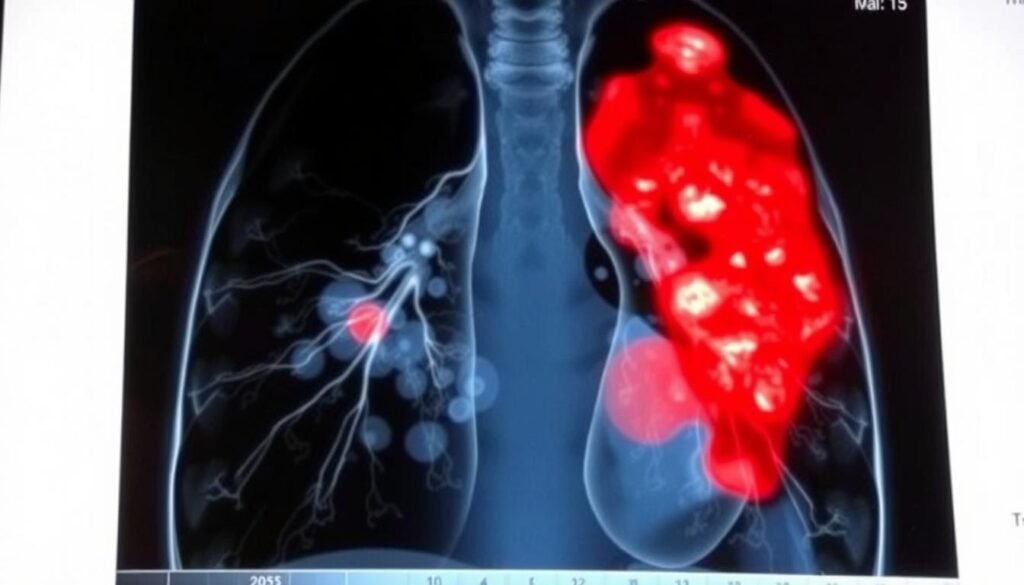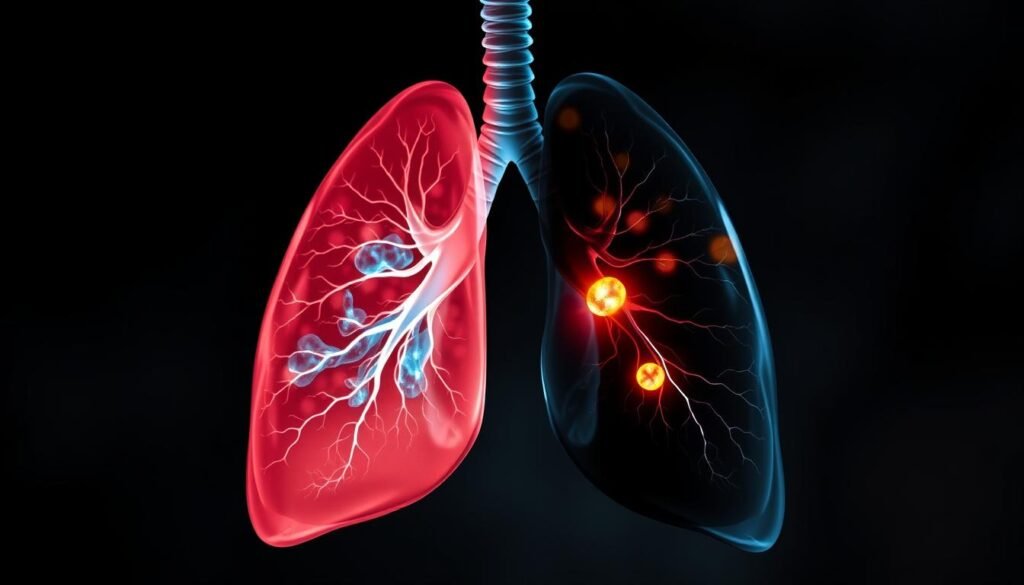In 2018, the U.S. saw about 234,030 new lung cancer cases. Lung cancer is the second most common cancer. It led to an estimated 154,050 deaths that year. The use of X-Rays in spotting lung cancer is key. These tools help find possible tumors and lung issues early. Finding the disease early can greatly help treatment and chances of survival.
Chest X-Rays (CXR) are the starting point in checking for lung cancer. Even with new technology, 90% of lung cancer cases that were wrongly diagnosed had used chest X-Rays. Yet, using CXR screening in people at risk has lowered lung cancer deaths by 18%. This shows how vital it is to know how these tools can spot cancer.
When healthcare workers learn more about X-Rays in finding lung cancer, they can find the disease sooner. This leads to better chances for patients.
Key Takeaways
- Chest X-Rays are typically the first test performed to detect lung abnormalities.
- Studies indicate that X-Ray screening can significantly reduce lung cancer mortality rates.
- 90% of misdiagnosed lung cancer cases used chest radiographs.
- Early detection plays a crucial role in improving treatment outcomes.
- Innovations in imaging techniques further enhance cancer detection capabilities.
Understanding Lung Cancer
Lung cancer is a major health problem with two main types: non-small cell lung cancer (NSCLC) and small-cell lung cancer (SCLC). It starts from unusual growth of lung cells. Smoking, being around harmful chemicals, and inheriting certain genes are causes of lung cancer.
Often, symptoms of lung cancer appear late in the disease. These common signs include:
- A persistent cough
- Breathlessness
- Chest pain
- Coughing up blood
Knowing these details early can help catch the disease sooner. Diagnosis typically involves different imaging tests. Chest X-rays are the starting point, giving early clues about lung problems.
After treatment for NSCLC stages 1, 2, or 3, a chest CT scan is suggested every six months for two years. People aged 50 to 80 who smoke or used to should get yearly lung cancer screenings.
While chest X-rays can hint at lung cancer, they often need more imaging to confirm. CT scans, thanks to new tech, provide a clearer view of the lungs and tumors.
| Type of Lung Cancer | Common Location | Characteristics on X-Ray |
|---|---|---|
| Non-Small Cell Lung Cancer (NSCLC) | Varies: Adenocarcinoma in the upper lobe, Squamous cell carcinoma in the middle | May show localized tumors, air pockets |
| Small Cell Lung Cancer (SCLC) | Middle of the chest | Often presents as large masses |
| Carcinoid Tumors | Middle of the lung | Can include calcification |
This brief uncovers the need to know the causes of lung cancer and spot its signs early. Taking steps if you’re at risk can lead to quicker finding and treating it. Many healthcare workers strive to better the lives of those with this serious disease.
Screening Options for Lung Cancer
Lung cancer is a big health issue in the US, where it’s the second most common cancer. There are several ways to detect lung cancer early. In the past, chest X-rays were common but they didn’t help much with survival rates. Now, the focus is on low-dose computed tomography (LDCT) scans for smokers at high risk.
The American Cancer Society advises people between 50 and 80 who smoked a lot to get annual LDCT screenings. This method is proving to save more lives compared to old ways. A study showed that people screened with LDCT had a better chance of surviving than those who just had X-rays.
LDCT scans use less radiation than full CT scans but more than chest X-rays. If you’re thinking about getting screened, find a place that knows how to do LDCT well. Most health insurance, including Medicare, will pay for this screening, which makes it easier for people to get.
The value of getting screened early can’t be overstated. LDCT scans can find lung cancer early which significantly helps in treating it successfully. It’s vital for those at high risk to keep an eye on their lung health.
https://www.youtube.com/watch?v=L0O38E73gzw&pp=ygUOI2x1bmdzY3JlZW5pbmc%3D
The Role of X-Rays in Lung Cancer Diagnosis
Chest X-rays are key for looking at lung cancer early on. They give us a first look at the lungs, quickly showing big tumors or changes. This info is vital for those with lung cancer signs. Knowing what X-rays can and can’t do helps catch cancer early.
Chest X-Ray Overview
Chest X-rays stand out for being fast and cheap. They’re usually the first step when doctors think it’s lung cancer. These tests can spot big issues in the lungs, hinting at cancer. Their widespread availability makes them a go-to in many places.
Limitations of Chest X-Rays
X-rays are great, but they have downsides. They might miss small tumors, under 1.5 cm, due to their low resolution. Because of this, 20% to 23% of tests might not catch cancer in people showing symptoms. This shows why we also need better imaging methods along with X-rays.
| Feature | Chest X-Ray | CT Scan |
|---|---|---|
| Detection of Small Tumors | Low ( | High |
| False Negative Rate | 20% – 23% | Much Lower |
| Cost | Inexpensive | Higher |
| Image Resolution | Low | High |
| Availability | Very High | High |
In summary, chest X-rays are crucial for finding lung cancer early. But, we must also use better imaging methods for a full check and diagnosis.
Low-Dose CT Scans for Lung Cancer Screening
Low-dose CT scans are changing how we screen for lung cancer. They offer many benefits over X-rays. Notably, they’re better at finding small tumors early. This early detection can make a big difference in treatment and outcomes for patients.
Advantages Over X-Rays
Compared to X-rays, low-dose CT scans have several benefits for lung cancer screening. Here are some of them:
- Increased Sensitivity: They can spot small lung nodules that X-rays might miss.
- Improved Image Quality: Low-dose CT scans give clearer and more detailed pictures, helping doctors see the lungs better.
- Lower Radiation Exposure: These scans use about 1.4 millisieverts (mSv) of radiation. That’s much less than standard CT scans, making them safer for patients.
Screening Guidelines and Recommendations
The American Cancer Society suggests who should get low-dose CT scans for lung cancer. It’s recommended for adults aged 50 to 80. Especially if they currently smoke or used to smoke a lot. These screenings could save about 60,000 lives every year in the U.S.
Findings from the NELSON trial show a big decrease in lung cancer deaths from these screenings. There was a 33% drop for women and 24% for men in ten years. These results highlight how crucial these screenings are. By finding tumors early, they help patients get better treatment faster.

Diagnostic Imaging Techniques for Lung Cancer
Several techniques are used to diagnose lung cancer. CT scans and PET scans are two key methods. Each has its own strengths in detecting the disease and its stage. Knowing how these tools work helps doctors choose the best one for diagnosis.
Comparison of Imaging Tests
There are different imaging tests for spotting lung cancer. Each test has its own benefits:
| Imaging Technique | Advantages | Limitations |
|---|---|---|
| Chest X-Ray | Simplicity, low cost, and wide availability | Does not significantly decrease lung cancer mortality rates |
| CT Scans | High-resolution cross-sectional images, enhanced detection of small nodules | Involves radiation exposure, may require further imaging |
| PET Scans | Detects metabolic activity of cancer cells, useful for staging | Higher cost, prolonged scanning time |
Importance of CT and PET Scans
CT scans give clear views of the lungs, helping spot tumors and how far cancer has spread. The use of MDCT technology makes scans even sharper and more accurate. CT scans are especially good at finding small lung nodules.
PET scans use a radioactive tracer, usually FDG, to highlight cancer cell activity. This is key for working out the cancer stage and spread. By using both CT and PET scans together, doctors can plan the best treatment. This approach improves the chances of a good outcome for patients.
Tumor Detection and Identification
Finding tumors early is key to treating lung cancer well. X-ray images show signs that can point to cancer. Tumors look like white-grey areas. They show certain features that might suggest a health issue.
Common Characteristics on X-Rays
Doctors look for specific traits in tumors to identify lung cancer. They notice:
- Irregular shapes: Tumors often have uneven forms.
- Varied edges: Their borders can be ragged, hinting at cancer.
- Different sizes: The size of a tumor affects how doctors treat it and figure out its stage.
These traits help doctors decide what to do next. They ensure patients get the right treatment quickly.
Determining the Next Steps After Detection
After spotting possible tumors, doctors usually suggest more tests. This can confirm cancer and show how much it has spread. They might use staging tests like biopsies. This helps them plan the best treatment, aiming to improve how well patients do.

Radiation Exposure Concerns
It’s key to know about radiation when looking at lung cancer screening. Different tests show different amounts of radiation. This raises health risk questions. A simple chest X-ray gives about 0.1 mSv of radiation. But, a CT scan can give around 10 mSv. This shows why choosing the right screening method matters.
Understanding Radiation Dosage
The average American gets about 3 mSv of radiation yearly from natural things like radon. Knowing this helps us understand diagnostic imaging radiation. Children are more sensitive to radiation than adults. This means we must be careful with imaging tests. Many studies look at high radiation risks. But it’s hard to know the risks of lower levels. Over time, radiation can increase lung cancer risk from screening.
Balancing Risks and Benefits of Screening
Doctors should talk with patients about screening risks and benefits. This helps patients make informed health choices. They focus on early detection versus radiation risks. High-risk people, like those 50 to 80 who smoked a lot, might need yearly low-dose CT scans. These can really help survival chances. For more safe screening tips, visit this resource.
Importance of Early Diagnosis
Finding lung cancer early is key to improving survival rates. The importance of early diagnosis is huge because only 21% of lung cancers are caught when the tumor hasn’t spread much. Most patients don’t see symptoms until the cancer has advanced, making effective treatment more difficult. Knowing the benefits of finding cancer early is crucial for patient recovery.
How Early Detection Affects Prognosis
Catching lung cancer early boosts the chance of surviving five years after finding it. Low-dose CT scans have shown they greatly lower the death rate from lung cancer. The National Lung Screening Trial showed early scans could cut death rates by about 20%. Early diagnosis not only helps people live longer; it also gives them more treatment choices, improving life quality.
The Role of Screening in Early Intervention
Screening guidelines consider age and smoking history. Groups recommend yearly low-dose CT scans for those 50 to 80 who smoked a lot. This plan highlights talking with doctors about screening’s value. The benefits of early detection outweigh the risks like radiation exposure and false alarms. This gives patients peace of mind and supports their mental health. For more on screening’s role in fighting lung cancer, click here.

Diagnostic Accuracy in Lung Cancer Detection
Chest X-rays are vital for finding lung cancer early. The radiologist’s skill and quality of equipment matter a lot. These factors help make lung cancer detection more accurate. In studies, the accuracy of X-rays varied, with results between 75.4% to 82.3%. It’s important to focus on image details. Despite this, 17.7% of patients got negative results even when they had lung cancer.
Factors Affecting Accuracy of X-Rays
Several factors impact how well chest X-rays can spot lung cancer:
- Radiologist Experience: A skilled radiologist is key for correct diagnosis.
- Imaging Quality: High-quality imaging equipment helps in clear picture capturing.
- Lesion Size and Location: The visibility of tumors depends on their size and where they are located.
- Timeliness of Imaging: Quick imaging and review help catch cancer earlier, improving the chances of successful treatment.
Enhancements in Imaging Technology
There have been major steps forward in lung cancer detection. New digital X-ray tech gives clearer images, helping find lung issues sooner. We need ongoing research for even better imaging methods. Adding tools like side-by-side radiographs greatly aids in spotting lung tumors.
Even though chest X-rays are crucial, they misdiagnosed 90% of lung cancer cases at some point. This highlights the importance of continually improving how we use X-rays. Following suggestions for regular checks can help catch cancer early, especially in those at high risk. For more details on how well different diagnostic techniques work, check out this study.
Potential Risks of X-Ray and CT Scanning
X-ray and CT scans are critical for diagnosing lung cancer. They can save lives. However, they come with potential risks that we need to understand. This knowledge helps make safe choices about screening.
Understanding Possible Complications
It’s important to know the risks of these scans. The main concern is the radiation you’re exposed to. It could slightly increase cancer risk over time. Research shows that one CT scan could raise the risk of fatal cancer to 1 in 2,000.
Then, there’s the issue with false positives. For example, a study found a false-positive rate of 21% for low-dose CT, compared to 9% for chest x-rays. False positives can lead to more tests and worry for patients. These issues tell us it’s crucial to think about the pros and cons of scans.
Patient Considerations Before Screening
Before getting screened, talk to your doctor about your health. Discuss any conditions you have and your risk factors. This conversation is key even though lung cancer causes about 160,000 deaths a year in the U.S. Screening can be beneficial, but it should fit your specific health needs.
In conclusion, knowing the risks of scanning is important. Being informed leads to better outcomes. Always discuss the benefits and risks of lung cancer screening with your doctor.
Conclusion
X-rays are very important in finding lung cancer early. About 66% of people with lung cancer had a chest X-ray before being diagnosed. Most X-rays find lung cancer as the diagnosis date gets closer. Yet, 23% of these X-rays don’t show the cancer, showing we need more ways to check for it.
Doctors are now using low-dose CT scans more than ever. These scans are better at finding lung cancer early compared to X-rays. Quick reporting of chest X-rays can cut the diagnosis time in half. So, people who might have lung cancer should talk to their doctors about different ways to check for it.
Knowing the pros, cons, and risks of each screening tool is key. Understanding all of this helps in finding lung cancer early. It ensures patients and their doctors can choose the best plan for managing lung cancer.